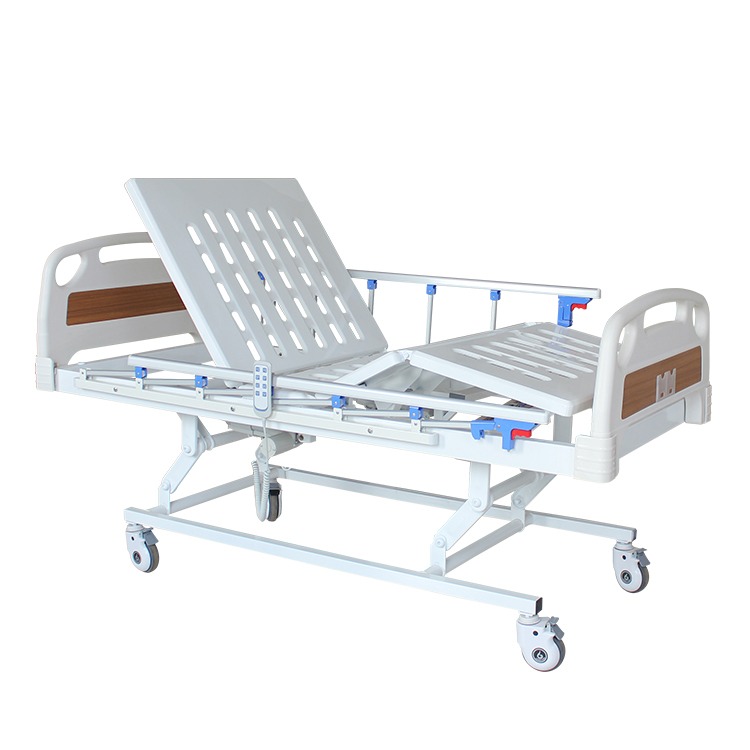3 Function Electric Bed
R18,600.00 Ex VAT
3 Function Electric Bed
1. head & foot board: PP
2. side-rails: 5 bars aluminum alloy
3. casters: independent locking casters
4. motor: Jieshun/Jiecang
5. mattress: Sold separately
6. infusion pole: stainless steel with 4
hooks
There are various types of hospital beds designed to cater to the specific needs of patients and healthcare providers. Here’s a comprehensive list of the main types of hospital beds and their uses:
1. Manual Hospital Beds
- Uses: These beds are adjusted manually using hand cranks. They are cost-effective and do not rely on electricity, making them useful in settings with limited resources or during power outages.
- Features: Adjustable head, foot, and height sections, but require physical effort to operate.
2. Semi-Electric Hospital Beds
- Uses: Suitable for patients who need frequent position adjustments but still offer a cost-effective solution compared to full electric beds.
- Features: Electrically adjustable head and foot sections, with manual height adjustment.
3. Full-Electric Hospital Beds
- Uses: Ideal for patients who require frequent adjustments and for caregivers who need to reduce physical strain.
- Features: Fully electric controls for adjusting head, foot, and height sections, improving patient comfort and caregiver convenience.
3 Function Electric Bed
1. head & foot board: PP
2. side-rails: 5 bars aluminum alloy
3. casters: independent locking casters
5. mattress: Sold separately
6. infusion pole: stainless steel with 4
hooks
There are various types of hospital beds designed to cater to the specific needs of patients and healthcare providers. Here’s a comprehensive list of the main types of hospital beds and their uses:
1. Manual Hospital Beds
- Uses: These beds are adjusted manually using hand cranks. They are cost-effective and do not rely on electricity, making them useful in settings with limited resources or during power outages.
- Features: Adjustable head, foot, and height sections, but require physical effort to operate.
2. Semi-Electric Hospital Beds
- Uses: Suitable for patients who need frequent position adjustments but still offer a cost-effective solution compared to full electric beds.
- Features: Electrically adjustable head and foot sections, with manual height adjustment.
3. Full-Electric Hospital Beds
- Uses: Ideal for patients who require frequent adjustments and for caregivers who need to reduce physical strain.
- Features: Fully electric controls for adjusting head, foot, and height sections, improving patient comfort and caregiver convenience.
4. Bariatric Hospital Beds
- Uses: Designed for overweight or obese patients, providing enhanced support and safety.
- Features: Wider frames, reinforced construction, higher weight capacity, and often include full electric functionality.
5. Low Hospital Beds
- Uses: Suitable for patients at risk of falling, such as the elderly or those with mobility issues.
- Features: Low height to reduce the risk of injury from falls, adjustable positions, and often equipped with side rails.
6. Gatch Beds
- Uses: Traditional hospital beds used mainly in less modern facilities.
- Features: Manual adjustments for head, foot, and height sections, similar to manual beds but often with fewer features.
7. Specialty Hospital Beds
- Uses: Designed for specific medical conditions or treatments.
- ICU Beds: For intensive care units, equipped with advanced monitoring and support features.
- Birthing Beds: For labor and delivery, adjustable to various birthing positions.
- Pediatric Beds: For children, smaller in size and often equipped with safety features like side rails.
- Psychiatric Beds: For psychiatric units, designed to minimize the risk of self-harm with features like concealed mechanisms and reduced ligature points.
8. Air Fluidized Beds
- Uses: For patients with severe pressure sores or burns, providing even pressure distribution and reducing the risk of pressure ulcers.
- Features: Uses a fluidized air system to suspend the patient on fine beads, offering maximum pressure relief.
9. Alternating Pressure Beds
- Uses: For patients at high risk of pressure ulcers, alternating pressure to different areas of the body to prevent sores.
- Features: Air cells that inflate and deflate alternately to redistribute pressure.
10. Low Air Loss Beds
- Uses: Similar to alternating pressure beds, designed to prevent and treat pressure ulcers.
- Features: Constant airflow to help maintain skin integrity and moisture control, reducing the risk of skin breakdown.
11. Lateral Rotation Beds
- Uses: For patients with limited mobility, designed to assist in turning and repositioning to prevent bedsores and respiratory complications.
- Features: Rotates the patient from side to side automatically, enhancing circulation and lung function.
12. Clinitron Beds
- Uses: Primarily for patients with severe wounds or burns, providing maximum pressure relief and skin protection.
- Features: Fluidized air technology similar to air fluidized beds, creating a low-pressure environment.
13. Stretchers/Gurneys
- Uses: For patient transport within the hospital, emergency situations, or procedures requiring mobility.
- Features: Simple design, often with basic head and foot adjustments, and mobility features like wheels and brakes.
Each type of hospital bed is designed to meet specific patient needs, enhancing comfort, safety, and care quality in various medical settings.
Related products
Uncategorized
Uncategorized
Uncategorized
Uncategorized
Uncategorized
Uncategorized
Uncategorized

















